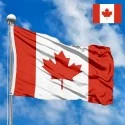The national flag of Canada, affectionately known as the "Maple Leaf Flag," is a globally recognized symbol of a modern, peaceful, and multicultural nation. Its clean, bold design and simple color scheme make it instantly identifiable and a source of immense pride for Canadians. Adopted in 1965, the flag represents a definitive break from colonial pasts and the birth of a new, independent identity based on unity, tolerance, and respect.
A Detailed Look at the Flag's Design and Symbolism
The flag of Canada consists of three vertical stripes in a design known as a Canadian pale. The two outer stripes are red, and the central stripe is white. The red stripes each occupy one-quarter of the flag's width, while the white stripe occupies the central half. At the heart of the white stripe is a stylized red maple leaf, a symbol that has become synonymous with the nation.
Each element of the flag is imbued with significant meaning, reflecting the core principles of the Canadian identity:
-
Red: The red color symbolizes sacrifice and courage, paying tribute to the Canadians who fought and died for their country. It is also associated with St. George's Cross, a historical symbol of England, and the red of the Union Jack. The color represents the vibrancy and energy of the Canadian people.
-
White: The white color represents peace, tranquility, and honesty. It is a direct reference to the snow-covered landscapes of Canada and the nation’s commitment to peace and justice. Historically, white was a color associated with the French monarchy, reflecting Canada's bicultural heritage.
-
The Maple Leaf: The maple leaf is the most prominent and iconic symbol of Canada. It has been used as an emblem of the country since the 18th century. It represents the natural beauty and resilience of the Canadian landscape, as well as the unique identity of the Canadian people. The eleven points on the stylized leaf are a design choice and do not hold any specific symbolic meaning related to provinces or territories.
Dimensions and Proportions
The official flag of Canada has a width-to-length ratio of 1:2. The three vertical stripes follow a 1:2:1 proportion, meaning the central white stripe is twice as wide as each of the outer red stripes. This specific design, known as the Canadian pale, ensures the central emblem remains a focal point. The precise design of the maple leaf, with its eleven points, is a matter of national law, ensuring its consistent and accurate reproduction.
The Genesis and Adoption of the Flag
The current Canadian flag is the result of a long and heated debate known as the Great Flag Debate of 1964. For decades, Canada had used the British Red Ensign, a red flag with the Union Jack in the canton, as its de facto national flag. As Canada gained more autonomy and a distinct national identity, Prime Minister Lester B. Pearson initiated a search for a new flag that would be uniquely Canadian.
The final design was proposed by historian and heraldist George Stanley, who was inspired by the flag of the Royal Military College of Canada. The design was officially approved by a parliamentary committee and adopted by proclamation of Queen Elizabeth II on February 15, 1965. This date is now celebrated as National Flag of Canada Day. The adoption of the new flag was a seminal moment in Canadian history, solidifying its identity as a sovereign nation.
Meaning and Significance for Citizens
For Canadians, the flag is a powerful emblem of their national identity, embodying the values of multiculturalism, diversity, and tolerance. It is a symbol of a country that is peaceful, prosperous, and committed to social justice. The flag is proudly displayed on government buildings, schools, and homes, particularly during national holidays like Canada Day on July 1st.
The simplicity of the design resonates with the Canadian spirit—it is a symbol that is inclusive and welcoming to all. The flag has become a shorthand for Canadian values around the world, representing a nation that is seen as a leader in international diplomacy and peacekeeping. For Canadians living abroad, the flag is a tangible link to their homeland and a source of deep-seated pride.
Interesting Facts
-
Before 1965, Canada had used various flags, but the Canadian Red Ensign was the most common. It featured the Union Jack in the corner and the Canadian coat of arms on a red field.
-
The flag's designer, George Stanley, was a historian and heraldist. He based his design on a simple and elegant principle: a national symbol that would be instantly recognizable and uniquely Canadian.
-
The flag is often referred to as "the maple leaf flag" or simply "the maple leaf" in common parlance.
-
The stylized eleven-pointed maple leaf on the flag is a botanical generic representation, not a specific species. The design was chosen for its clean lines and visibility.
-
February 15th is celebrated as National Flag of Canada Day to commemorate the date the flag was officially adopted.
In conclusion, the flag of Canada is more than just a national symbol; it is a declaration of a nation's identity and values. Its simple yet powerful design tells a story of unity, peace, and a distinctive Canadian spirit. It is an emblem that continues to inspire and unite Canadians, both at home and around the world.
In the demonstration images, full-size flags are shown with proportions of 2:3, and hand-held flags with proportions of 1:2.






 Waving flag
Waving flag
 Sizes:
Sizes:
 Round flag
Round flag
 Sizes:
Sizes:
 Rectangular flag 2:3
Rectangular flag 2:3
 Sizes:
Sizes: